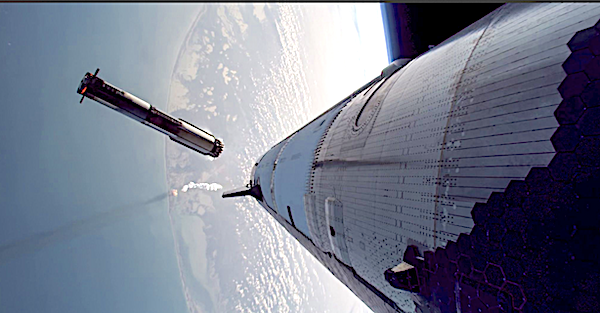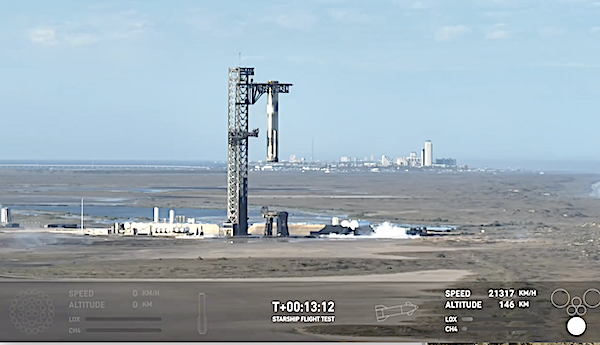
The ninth flight test of Starship is preparing to launch as soon as Tuesday, May 27. The launch window will open at 6:30 p.m. CT.
A live webcast of the flight test will begin about 30 minutes before liftoff, which you can watch here and on X @SpaceX. You can also watch the webcast on the X TV app. As is the case with all developmental testing, the schedule is dynamic and likely to change, so be sure to check in here and stay tuned to our X account for updates.
After completing the investigation into the loss of Starship on its eighth flight test, several hardware changes have been made to increase reliability. You can read the full technical summary of the mishap investigation here.
The upcoming flight test marks the first launch of a flight-proven Super Heavy booster, which previously launched and returned on Starship’s seventh flight test. In addition to the reuse milestone, Super Heavy will fly a variety of experiments aimed at generating data to improve performance and reliability on future boosters. The Starship upper stage will repeat its suborbital trajectory and target objectives not reached on the previous two flight tests, including the first payload deployment from Starship and multiple reentry experiments geared towards returning the vehicle to the launch site for catch.

Super Heavy is designed to be fully and rapidly reusable, with future generations capable of multiple launches per day. To achieve this first ever reflight, extensive inspections took place following the booster’s first launch to assess hardware health and identify where maintenance or replacement hardware was needed. Known single-use components like ablative heat-shielding were replaced, but a large majority of the booster’s hardware will be flight-proven, including 29 of its 33 Raptor engines. Lessons learned from the first booster refurbishment and subsequent performance in flight will enable faster turnarounds of future reflights as progress is made towards vehicles requiring no hands-on maintenance between launches.
The booster on this flight test is also attempting several flight experiments to gather real-world performance data on future flight profiles and off-nominal scenarios. To maximize the safety of launch infrastructure at Starbase, the Super Heavy booster will attempt these experiments while on a trajectory to an offshore landing point in the Gulf of America and will not return to the launch site for catch.
Following stage separation, the booster will flip in a controlled direction before initiating its boostback burn. This will be achieved by blocking several of the vents on the vehicle’s hotstage adapter, causing the thrust from Starship’s engines to push the booster in a known direction. Previous booster flips went in a randomized direction based on a directional push from small differences in thrust from Starship’s upper stage engines at ignition. Flipping in a known direction will require less propellant to be held in reserve, enabling the use of more propellant during ascent to enable additional payload mass to orbit.
After the conclusion of the boostback burn, the booster will attempt to fly at a higher angle of attack during its descent. By increasing the amount of atmospheric drag on the vehicle, a higher angle of attack can result in a lower descent speed which in turn requires less propellant for the initial landing burn. Getting real-world data on how the booster is able to control its flight at this higher angle of attack will contribute to improved performance on future vehicles, including the next generation of Super Heavy.
Finally, unique engine configurations will be demonstrated during the Super Heavy’s landing burn. One of the three center engines used for the final phase of landing will be intentionally disabled to gather data on the ability for a backup engine from the middle ring to complete a landing burn. The booster will then transition to only two center engines for the end of the landing burn, with shutdown occurring while still above the Gulf of America and the vehicle expected to make a hard splashdown.
The Starship upper stage will again target multiple in-space objectives, including the deployment of eight Starlink simulators, similar in size to next-generation Starlink satellites. The Starlink simulators will be on the same suborbital trajectory as Starship and are expected to demise upon entry. A relight of a single Raptor engine while in space is also planned.
The flight test includes several experiments focused on enabling Starship’s upper stage to return to the launch site. A significant number of tiles have been removed from Starship to stress-test vulnerable areas across the vehicle during reentry. Multiple metallic tile options, including one with active cooling, will test alternative materials for protecting Starship during reentry. On the sides of the vehicle, functional catch fittings are installed and will test the fittings’ thermal and structural performance. The entire ship’s tile line also received a smoothed and tapered edge to address hot spots observed during reentry on Starship’s sixth flight test. Starship’s reentry profile is designed to intentionally stress the structural limits of the upper stage’s rear flaps while at the point of maximum entry dynamic pressure.
Developmental testing by definition is unpredictable. But by putting hardware in a flight environment as frequently as possible, we’re able to quickly learn and execute design changes as we seek to bring Starship online as a fully and rapidly reusable vehicle.
